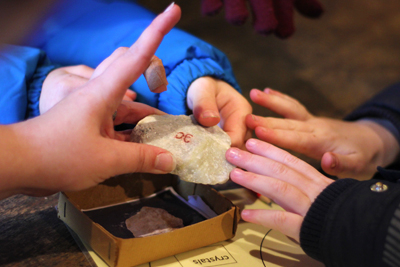Wednesday 11th January: not only my Stepmother’s Birthday and the first of the family celebrations of the year but it was also our first School visit. This practical session encourages the children to handle and sort a wide range of rock samples by looking at the key features such as grains, crystals, layers or bubbles.
Rodmersham Primary Are Rock Stars!

We discussed the rock cycle and the characteristics of the different types of rock - igneous, metamorphic (hot rocks) and sedimentary (cold rocks). Hot rocks are pushed out of the earth from volcanoes or get heated up again and change into something new a bit like a butterfly changing from a caterpillar. Cold (sleepy) rocks are laid down, sometimes these will have big or small bits of other rocks that have been eroded from another place and are the type of rock where fossils can be found.
We then explored the Nature Park. Where there are piles of flint, chalk banks, stone walls, a pebble beach, large Sarson stones near the pond (crystalline sandstones) and granite chip pathways.
We discovered the Kent Rock display beside the long grass mini-beast area shows all the different types of rocks that you can find in Kent. This display shows that rocks take millions of years to form and transform!
Some rocks are formed by the grains being stuck together by making a kind of glue. This is formed as they become squashed down by the weight of grains on top of them. They dissolve a bit and then stick together - like a sugar cube. One theory is that if there were other chemicals in the area this could increase the glue. I suggested that in some circumstances that it could be dinosaur pee that was the extra chemical!
Some of the comments from the children included:
“Rocks take a long time to form”
“Igneous rock is formed by volcano lava cooling down”
“Layers of sand grains press down to make rocks”
“We looked at smooth, bubbly and rough rocks”
“A fossil is a dead animal”
“lava rock, has bubbles – it is light because it is full of air”
One of the best facts of the day was that “sandstone could be made harder and stuck together better by dinosaur pee”.
It was a busy morning, as well as discovering that rocks are found beneath the soil they also help to make soil. We even had a go at making our own! They discovered that soil is made up of “sand and or clay and dead bits” and were intrigued that this included dead animals as well as dead plants / fallen leaves.
We discussed the importance of soil for different habitats and for the plants in them. The students told us what plants needed to grow – water, sun and nutrients. Soil plays a vital role in the amount of water and nutrients plants get, and that “dead bits are the nutrients!”
We used sand, clay and compost to try and make a soil that would have both good drainage and nutrient content. The students took their soil creations with them and were going to use them for an experiment to discover the difference in drainage.
The children were asked to describe their creations
“it was fun making soil”.
“dirt and chocolate cake” “bark brown”
Feels like:
“squidgy” “smooth and soft” “rough and grainy” “weird”
-------------------------------------------------
by the Education & Community Engagement Team